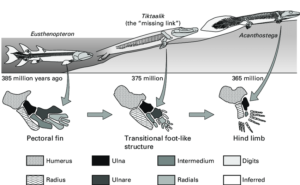The Discovery of Tiktaalik and its Impact on Evolutionary Biology
Written by: Claudia Kowal
For years, scientists have attempted to find a transitional species between aquatic and land vertebrates. Without this species, there seemed to be a gap in the evolutionary tree: the first organisms on Earth lived in water, but many evolved to live on land. In order for this evolution to occur, there had to be a transitional species that existed between the development of these two forms (Ashley-Ross, Hsieh, Gibb, & Blob, 2013). In an attempt to find this species, Dr. Neil Shubin of the University of Chicago and his colleagues conducted a trip to Nunavut Canada in 2004, where they discovered a 375 million-year-old fossil which they named Tiktaalik. Tiktaalik was believed to be the best representative of the alleged transitional species scientists needed to prove evolution. This discovery was crucial because it changed the public’s understanding of tetrapod anatomy and evolutionary biology as a whole (University of Chicago Medical Center, 2014).
Our Previous Understanding of Tetrapod Evolution
The anatomy of Tiktaalik disproved much of what scientists previously believed about land vertebrate evolution. Previously, there were several ideas about the limb structure of fish-tetrapod transitional species, which claimed that terrestrial limbs developed after organisms transitioned from water to land. However, Tiktaalik possess a unique trait — they are able to push themselves up using their arm-like fins. The anatomy of Tiktaalik demonstrates that the transition from fin to limb had occurred partially in water-residing organisms; disproving the proposal that the change occurred in early terrestrial organisms (University of Chicago Medical Center, 2014).
Still, there were some gaps in scientists’ knowledge of Tiktaalik’s anatomy– the team had only found the front end of the fossil. That is until Neil Shubin conducted another trip to Nunavut in January 2014 and discovered a fossil of the back end of Tiktaalik. Its hips were unexpectedly sturdy, which suggested that it possessed very strong hind limbs. The scientists reasoned that its strong limbs pointed towards the fact that the Tiktaalik likely used their limbs to push themselves up and navigate around the land (Magazine & Adler, 2014). Shubin and his team had more reason to believe that Tiktaalik was a hybrid land and water organism, which helped disprove the original idea that limbs had developed on organisms after they transitioned to land.
Figure 1

In this image, you can clearly see the transition from fish to tetrapod. Tiktaalik features a unique foot-like limb, thought to be found in only tetrapods.
Source: Cambridge University
How Tiktaalik Helped Support Darwin’s Theory of Evolution
Darwin’s theory of evolution was heavily based on the idea that all organisms are connected and evolved from one common ancestor. Although this theory is widely accepted among scientists, it is difficult to provide a link between aquatic organisms and terrestrial organisms. After all, their anatomy is completely different from each other and their ways of life, as well. Because of this conflict, there was considered to be a ‘gap’ or ‘missing link’ in Darwin’s Theory. Transitional fossils- like Tiktaalik- are important because they are crucial pieces of evidence for evolution (Sherwin, 2006). As shown in Figure 1, the limb structure of Tiktaalik served as a transition between aquatic organisms and land tetrapods. Therefore, the discovery of Tiktaalik was incredibly supportive of Darwin’s Theory, as it directly filled in the supposed ‘gap’.
Conclusion
The discovery of Tiktaalik was crucial to our understanding of evolution. The transitional fossil discovered helped us create new ideas regarding the aquatic to terrestrial organism evolution. Additionally, it helped support Darwin’s theory of evolution. Overall, the discovery of Tiktaalik has only helped further our understanding of evolutionary biology as a whole, and filled in an alleged ‘gap’ in the evolutionary tree. However, there are still important questions that arose from Tiktaalik’s discovery. Supposedly, Tiktaalik adapted its hind limbs to avoid predators in the water. To what extent do environmental factors affect the evolution of organisms? And why are only some organisms affected by this- what makes them adapt better to their environment? These are all questions that Darwin strived to answer, and we are now able to answer them using modern technology and resources. Darwin laid the foundation for evolutionary biology, and now we are able to carry on his legacy by making new discoveries in the field.
References and Sources
Ashley-Ross, M. A., Hsieh, S. T., Gibb, A. C., & Blob, R. W. (2013). Vertebrate Land Invasions–Past, Present, and Future: An Introduction to the Symposium. Integrative and Comparative Biology, 53(2), 192–196. https://doi.org/10.1093/icb/ict048
Kampourakis, K. (2014, January). Figure 1.5 The fossils of Tiktaalik were found where they were… Retrieved from ResearchGate website: https://www.researchgate.net/figure/The-fossils-of-Tiktaalik-were-found-where-they-were-predicted-to-be-and-provide-evidence_fig4_255709398
Magazine, S., & Adler, J. (2014, June). Did the Evolution of Animal Intelligence Begin With Tiktaalik? Retrieved September 25, 2022, from Smithsonian Magazine website: https://www.smithsonianmag.com/science-nature/evolution-animal-intelligence-begin-tiktaalik-180951428/#:~:text=In%202004%2C%20when%20the%20fossil%20bones%20of%20Tiktaalik
Sample, I., & correspondent. (2014, January 13). Tiktaalik fossils reveal how fish evolved into four-legged land animals. The Guardian. Retrieved from https://www.theguardian.com/science/2014/jan/13/tiktaalik-fossil-fish-four-legged-land-animal
Sherwin, F. (2006, April 11). Tiktaalik: Our Ancestor? Retrieved September 25, 2022, from www.icr.org website: https://www.icr.org/article/tiktaalik-our-ancestor/
University of Chicago Medical Center. (2014, January 13). Discovery of new Tiktaalik roseae fossils reveals key link in evolution of hind limbs. Retrieved from ScienceDaily website: https://www.sciencedaily.com/releases/2014/01/140113154211.htm